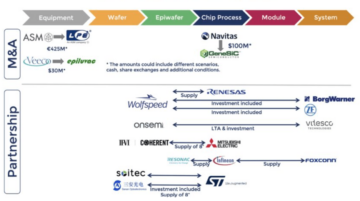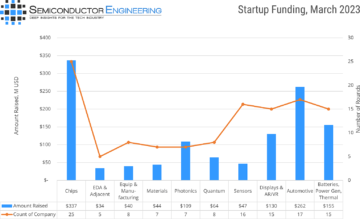Virtual sensors; BootROM verification; PCB DFM; WBG power electronics.

Synopsys’ Emilie Viasnoff suggests that employing virtual sensors when developing an autonomous driving system helps aid in sensor design and minimizes the hazards associated with extensive real-world driving.
Cadence’s Anthony Ducimo introduces a methodology for embedded BootROM verification that relies only on standard RTL verification toolchains to reveal bugs, identify unused sections of the BootROM code, and expose untested features.
Siemens’ Stephen Chavez argues for the importance of design for manufacturability in the PCB design process and finds that adhering to IPC guidelines, including external stakeholders, and shifting DFM analysis left helps streamline production and mitigate errors.
Keysight’s Emily Yan considers the impact wide bandgap semiconductors will have on power electronics trends in 2024 and how they could redefining the design and simulation workflows for the next decade.
Ansys’ Pavani Gottipati and Jingchen Liang find that the increasing demand to charge electronic devices faster means thermal management is necessary to protect wireless chargers from overheating problems and point to some of the unique thermal challenges.
Arm’s Richard Grisenthwaite points out two initiatives the company is taking in furtherance of a common framework for chiplet partitioning and interface standardization.
Renesas’ Carlos Rodriguez notes that despite the temptation to choose the biggest, most powerful 32-bit or 64-bit MCU available, in many cases a less powerful, lower-bit-count MCU is a better fit for the job.
SEMI’s Margaret Kindling chats with Antoinette Hamilton of Lam Research about the semiconductor industry’s progress towards diversity, why inclusion is critical to everyone’s success, and how companies and leadership can effect greater change.
Plus, check out the blogs featured in the latest Manufacturing, Packaging & Materials newsletter:
Editor in Chief Ed Sperling digs into Intel’s foundry push and why it’s starting to win converts.
Lam Research’s James Kim shows how a biased deposition or etch process can create structural defects in different radial directions, leading to performance variability.
Synopsys’ Vivek Jain argues that the data generated in a fab needs to be analyzed and acted on quickly to ensure tight process control, high yield, and avoid process excursions.
SEMI’s Mark da Silva, Nishita Rao, and Karim Somani call for the industry to collaborate in developing a common understanding of digital twin technology across various hierarchical levels.

Jesse Allen
Jesse Allen is the Knowledge Center administrator and a senior editor at Semiconductor Engineering.
- SEO Powered Content & PR Distribution. Get Amplified Today.
- PlatoData.Network Vertical Generative Ai. Empower Yourself. Access Here.
- PlatoAiStream. Web3 Intelligence. Knowledge Amplified. Access Here.
- PlatoESG. Carbon, CleanTech, Energy, Environment, Solar, Waste Management. Access Here.
- PlatoHealth. Biotech and Clinical Trials Intelligence. Access Here.
- Source: https://semiengineering.com/blog-review-feb-28-2/
- :is
- 2024
- 25
- 28
- 6
- 62
- 7
- 80
- a
- About
- across
- adhering
- Aid
- All
- All Posts
- allen
- alternative
- an
- analysis
- analyzed
- and
- Argues
- ARM
- associated
- At
- autonomous
- available
- avoid
- BE
- Better
- biased
- Biggest
- Blog
- blogs
- bugs
- Cadence
- call
- CAN
- cases
- Center
- challenges
- change
- charge
- chats
- check
- chief
- Choose
- code
- collaborate
- Common
- Companies
- company
- considers
- control
- converts
- could
- create
- critical
- DA
- data
- decade
- Demand
- Design
- design process
- Despite
- developing
- Devices
- different
- digital
- digital twin
- digs
- directions
- Diversity
- driving
- editor
- effect
- Electronic
- Electronics
- embedded
- employing
- Engineering
- ensure
- Errors
- Ether (ETH)
- everyone’s
- extensive
- external
- faster
- featured
- Features
- Feb
- Find
- finds
- fit
- For
- Foundry
- Framework
- from
- generated
- greater
- guidelines
- Hamilton
- Have
- helps
- High
- High Yield
- How
- HTML
- HTTPS
- identify
- Impact
- importance
- in
- Including
- inclusion
- increasing
- industry
- industry’s
- initiatives
- Interface
- into
- Introduces
- Job
- jpg
- karim
- knowledge
- Lam
- latest
- Leadership
- leading
- left
- less
- levels
- management
- many
- materials
- MCU
- means
- Methodology
- minimizes
- Mitigate
- most
- necessary
- needs
- next
- Notes
- of
- on
- only
- or
- out
- packaging
- pcb
- performance
- plato
- Plato Data Intelligence
- PlatoData
- Point
- points
- popularity
- Posts
- power
- powerful
- problems
- process
- Production
- Progress
- protect
- Push
- quickly
- real world
- Redefining
- relies
- research
- reveal
- review
- ROW
- sections
- Semi
- semiconductor
- Semiconductors
- senior
- sensors
- SHIFTING
- Shows
- Siemens
- silva
- simulation
- some
- stakeholders
- standard
- standardization
- Starting
- streamline
- structural
- success
- Suggests
- system
- taking
- Technology
- text
- that
- The
- thermal
- they
- thumbnail
- to
- towards
- Trends
- twin
- two
- understanding
- unique
- untested
- unused
- various
- Verification
- Virtual
- when
- why
- wide
- will
- win
- wireless
- wireless chargers
- with
- workflows
- Yield
- zephyrnet












